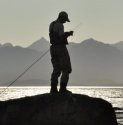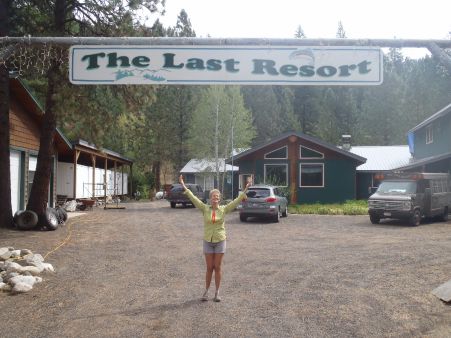Fd: Before we get to techniques, how did you first get into carp fly fishing?
Dan: I went on a trip to Colorado with my Dad, Uncle and Brother. On a bit of a lark we took a fly fishing class and half day of guided trout fly fishing. Immediately, I was hooked and knew I needed more. The tough part is I live in South Eastern South Dakota. The nearest cold water is at least 300 miles away and saltwater is a helluva lot further than that. To make matters worse, even the traditional warm water species like bass aren’t overly abundant here. Most fishing in South Dakota is in deep water to walleye. There were, however, fish that I could see and they were carp. So I started toiling away trying to figure out how to catch them. That was almost a decade ago. Back then there wasn’t much information out on how to get these fish to eat a fly and I had to learn a lot of it on my own. Add to that that I still held the stupid American bias that these are trash fish, not worth catching, and it meant I was not only on my own, I lied when asked what I was fishing for. By the time I learned that anyone else bothered to chase these fish with flies, I’d been catching them for years.
Fd: How can one find the spots where carp are when approaching new waters?
Dan: Carp can be anywhere, so the right spots to fish for them are less about finding the fish and more about how fishable the water is. In order to consistently catch carp, an angler needs to have pretty good visuals on the fish. This is almost totally a sight fishing game, so your first order of business is finding water shallow enough that you can get a chance of seeing the carp, or at least seeing it’s mud plume or bubbles.
Secondarily, think about feeding scenarios. Carp feed in the shallows because stuff lives in the shallows. In order to be as successful as carp are, it’s also required that they feed EFFICIENTLY. That means they will focus on feeding in rich shallow areas. In still water that is often shallow, mud bottomed bays or weedy areas or along rocky flats. In moving water, they are more likely to be in the slack water, or holding in traditional trout water. Places where the food comes easy and often.
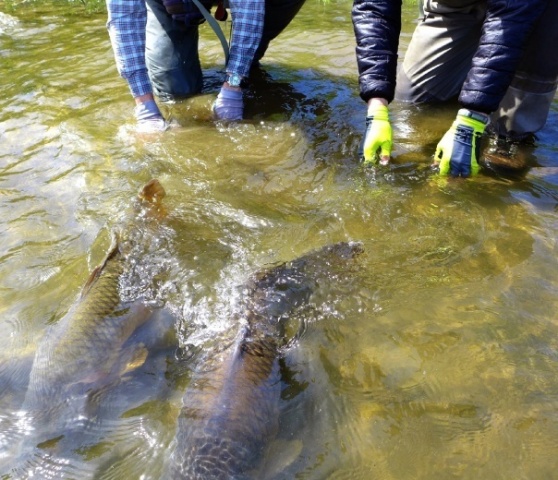 Fd: What are the best conditions for carp fly fishing in regard to weather, water, temperature currents, etc.?
Fd: What are the best conditions for carp fly fishing in regard to weather, water, temperature currents, etc.?Dan: Part of the appeal of carp is that they are most easily accessed in the heat of the summer, when other fishing can be off. Carp can, and are caught year round, but the best carp fishing seems to happen when the water temp breaks 50 degrees Fahrenheit all the way up to the 90s. Carp will simply get more active as their metabolisms increase with the higher water temps. Their ability to tolerate low oxygen content means that even at high temps the carp are very active.
Water and weather are actually related in this question. Carp fly fishing is all about seeing the fish. That means that bluebird sunny days, with little or no wind and high sun, are the best weather conditions because they increase your ability to see the fish. Just the kind of days that other fish are sulking, the carp should be feeding.
The same theory applies to water type. Seeing the fish is the most important part of the game. They will be tailing like redfish or cruising along slowly and picking up food like bonefish. So you want water that affords visibility. Clear, shallow water with access to nearby deep water for the fish to come up out of is best. In rivers, you’re looking for slow side channels, backwaters and frog water. Carp want to eat A LOT but they don’t want to work for it. If they can’t get totally out of the current, look for them in traditional trout holding lies. Places where the current is broken or softened.
Fd: What about going for them during the winter?
Dan: Carp will go deep in the winter. If you have water where the deepest holes are fishable when the temp gets colder, you can sure get a carp out of those holes. Try nymphing through them or using an egg pattern. But the fact is, carp are the most fun when you can get good visuals on the fish, either tailing or eating off of the surface.
Unless you have places where you can see the fish once it’s gone deep for winter, you are going to have a tough time getting them. That said, carp feeding turns on when water temps rise relative to what it has been. That is to say, a move from 45 degree water to 50 degree water will trigger feeding just like a move from 65 degree water to 70. So if you can find fish in the winter and fish them after a couple of relatively warm days, catching them is certainly possible.
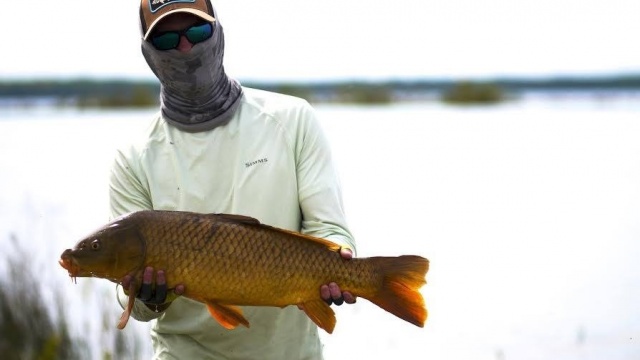 Fd: What are the main organisms and vegetation that carp feed on?
Fd: What are the main organisms and vegetation that carp feed on?Dan: This is where the great beauty of carp flyfishing comes in. Carp have been successfully introduced all over the globe. The reason all of the introductions have been so successful is that carp are Generalists. That is to say, they eat most anything. Generalist species tend to introduce far better than more specialized fish. But now let’s complicate matters. Carp, as a species, are generalist. Local carp populations are specialists. Meaning: on any given water body, carp will specialize in eating whatever is most efficient to the near exclusion of most anything else.
I have been on one pond where the fish were eating baby crayfish as fast as they could, walked over to an adjacent pond and had them spook off any crayfish fly but eat nymphs like mad. So that makes this a tough question. The answer is, know your forage. Spend time finding out what is most abundant on the water you want to fish and then throw flies that emulate that. For the most part, small animals (under an inch long) like nymphs and baby crayfish or little baitfish are the most likely. As for vegetation, look for falling cottonwood seeds or mulberries. Carp sip them like dry flies.
Fd: Carp demand a good presentation of the fly and strong leaders as well. What kind of leader setup do you recommend? What about the knots?
Dan: You’re right about this. They are very demanding of presentation. I fish 1x to 3x tapered leaders and tippets, based on the size of the fish and clarity of the water. I tend toward a mono leader rather than fluoro, but that is certainly up for debate. I then use a Bimini Twist in the tippet with a Double Surgeon to the leader. A non-slip mono Loop knot connects the fly to the tippet. Maintaining as much action on the fly as possible for presentation sake is key. Thus the Loop knot and fishing tippet as light as I can get away with. Because I’m using that light tippet, I need to preserve the breaking strength when tying my knots, thus the Bimini Twist.
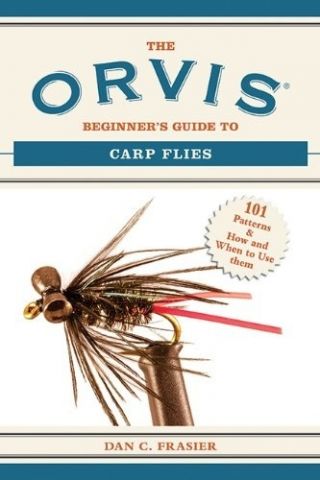 Fd: What would be a good selection of flies for carp so as to cover diverse situations?
Fd: What would be a good selection of flies for carp so as to cover diverse situations?Dan: Again this is very situation dependant. On the Great Lakes: big meaty inch and a half long flies are used, while on the Columbia River the fish won’t even look at a fly bigger than your thumbnail. So know and understand your situation. That said, generic nymph and crayfish flies in the 6 to 10 range tend to work most places. When the carp are eating on top, generic dries work well; Adams, small hoppers, etc. In my book, The Orvis Beginner's Guide to Carp Flies: 101 Patterns & How and When to Use Them, I break the fly selection down into categories based on the situation an angler is facing and give specific patterns to use. That said, it took 101 flies to cover all the variation out there, and I am SURE there is more.
Fd: What about tempting carp when they are inspecting the mud bottom?
Dan: This is actually how most carp are caught. They are fished-to like tailing redfish, bonefish or permit with small crayfish, leeches and nymph patterns. You look for a fish that is inspecting the bottom for food or mudding and then put a fly in front of him. Give small strips to emulate a fleeing animal or just let it sit there until he finds it. I will tell you that these fish are not pushovers. Conway Bowman told me, on my podcast, that they are tougher to catch than permit in his opinion. It’s just that you can get so many shots you can get some. Another famous fly fishermen echoed those same sentiments to me recently on a trip we were on together.
Catching them on top is the rarity. In some places carp are voracious topwater feeders, like my home water, and are caught on dry flies regularly. But in most places a carp would rather feed on the bottom than the top. If they are eating on the bottom and you can see them pretty well, that is the best target you can find when carp fly fishing.
Fd: Should the fly always approach the carp’s mouth motionless? Does moving the fly provoke these fish into taking it?
Dan: When fishing dries, I think motionless is the right way to go. Every once in a while, a small twitch might help get their attention if you are fishing them in still water, but usually it just spooks them. Dead drift whenever possible.
Now, when you are fishing to tailing fish, a well-timed very small strip is often in order. Make your fly look like it’s a fleeing bait item and you can induce some serious takes. You still need to feed these flies to the fish. They aren’t going to run it down and crush it usually, but a small strip to get their attention is good in most places. One trick is to know that if the carp are ignoring your fly, you should put less motion on it. Shorten your strips and go without when you know the fish is seeing your fly but just not chasing it. Often times, those fish will swim over and eat a motionless item that looked like too much work if it was running away.
Fd: In those days when we can’t spot any carp, should we just go home?
Dan: Ninety-nine percent of the fly fishing done for carp is sight fishing. The fishing is just delicate enough that you need to know the fish is there and eating in order to get him. The takes can be disgustingly subtle and carp are great at spitting out things that aren’t food. So you need to see what is going on. There is a small group of anglers that use egg flies suspended under strike indicators to get fish that they know are there, but can’t see. Whether they are creating bubbles while eating on the bottom or a mud plume or something, you still have to have an idea that fish are there. That’s a good way to get them when you can’t see exactly where they are.
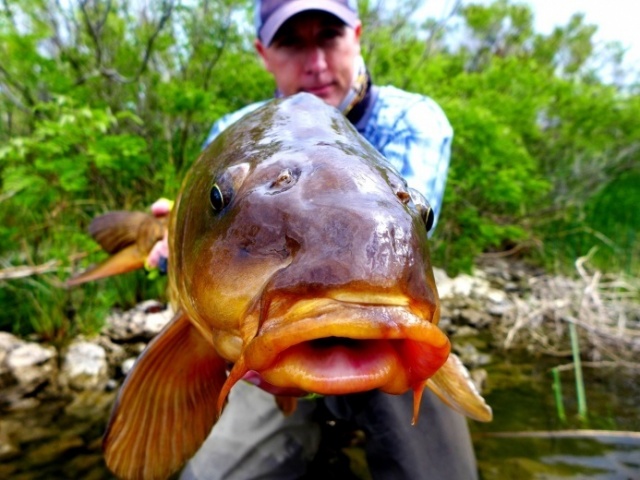 Fd: Could you describe the “Drag and Drop” technique?
Fd: Could you describe the “Drag and Drop” technique?Dan: This is a unique presentation technique that was independently developed by a number of carp fly fishermen around the US. Strangely, many people came up with it separately; which I think speaks to its effectiveness. The presentation goes like this. The fly is cast beyond the spot you eventually want it to end up. The angler then lifts the rod tip and skitters (and steers) the fly across the surface until it is directly above the “dinner plate” of a fish that is tailing or feeding on the bottom. Once the fly is there, the rod tip is lowered; allowing the fly to settle down through the water column and into the feeding zone of the fish.
This presentation does a couple of things. It allows for an amazingly accurate presentation. Because you can steer the fly to be directly above where you want it to drop, you can put a fly in a very small area repeatedly. Additionally, it means that the fish sees a fly that is falling through the water column just like a small creature fleeing to hide in the bottom. That’s a unique way of showing the fish a moving fly without moving it away from them. The drawback is that it only works from about 35 feet and in. An angler needs to stalk very quietly and get that close to a fish, but if you do you can put a fly exactly where you want it. I’ve used it on redfish and bonefish as well and it can be deadly.
Fd: Any other tip or final words for those who haven’t tried carp on the fly yet?
Dan: They aren’t easy. It can take a lot of time to figure out the fish you are fishing, so you have to keep trying. Once you learn a certain population of fish, the next population is easier as you go. Keep after it and don’t be surprised if you struggle to catch fish for a long while when you first start. Knowing your forage is the most important thing. Once you know what they are eating, you can think long and hard about your fly and about how to present it. That will make a huge difference.
Dan's book will be released in January of 2015. Here is a pre-order link: The Orvis Beginner's Guide to Carp Flies: 101 Patterns & How and When to Use Them

